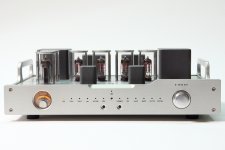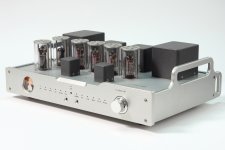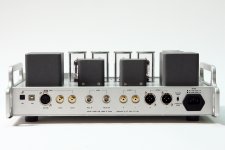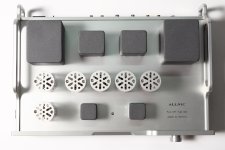- Thread Author
- #1
The New Allnic D5000 DHT tube dac is finally available in North America. I have been a huge fan of Allnic since my introduction to them two years ago by John Wright, former engineer for Ed Meitner. I recently became familiar with Direct Heated Triode tubes with the purchase of a used Allnic L5000 Linestage (preamp) which lists for $23K. So my heart leapt like a gazelle when I heard this was in production.
To begin, I am very impressed with Waversa Systems digital architecture design. Most of the components are custom designed for this application. I believe the designer offers a fresh perspective and addresses areas where other dac designs fall short. Most important to me is complete galvanic isolation of the USB input which eliminates noise from the switch power supply of source components. This will likely negate the sonic benefit of my custom ten-rail linear power supply designed by Paul Hynes ($5000). But this alone to me makes their dac competitively priced, given the potential front end savings. I will also perform a USB cable comparison to determine any sonic benefit between a range of cables, including my $1600 Vertere Pulse-R USB 1.5 meter cable.
The analog output uses a fully balanced circuit from input to output with no coupling capacitors, only all pure nickel permalloy cored transformers. Each channel uses twin 3A5(DCC90) DHT tubes. The DHT 3A5 amp’s frequency range is from 20 Hz to 50 kHz (-3dB) with a perfect square wave form of 20 kHz. 3A5 tubes operate at a very low temperature that ensures long tube life. The circuit displays no negative feedback, not even a partial feedback. This design has absolutely no microphonic issues, which is the biggest obstacle to DHT realization. KS Park’s design resolved this issue through a newly designed 7-pin gel damper socket. In addition, the main PCB is floated with a drum rubber specific for this application. High S/N ratio and dynamic operation is achieved through full tube designed automatic voltage regulation which protects the DHT amp from both internal and outside voltage irregularities. The front panel displays a current meter which monitors safe operation and status of the tubes.
The D5000 is very unique in today’s DAC world because most of its components are not from any routine audio market source except the DAC chips. The USB interface, SPDIF receiver and high end upsamplers are all specifically customized for this application. D5000 uses very unique technologies for audio signal processing. The clock does not directly connect to the DAC chip. Instead, the audio processor uses clock alignment algorithms that determine exact alignment for the DAC chip in a real-time manner. The ES9018K2M SABRE 32 Reference DAC chip is a high performance 32-bit, 2-channel audio D/A converter with sampling to 32/384 kHz, 128 DSD and uses a 1.5 MHz upsampler through a field-programmable gate array USB interface.
While most ES9018K based DACs use the dac chip for audio processing, the D5000 has a proprietary internal processor that performs real time PCM upsampling or upsampling and conversion to DSD. The SABRE Reference DAC chip only performs the digital to analog conversion.
Real-time PCM to DSD conversion function is implemented when “conversion” is selected. All input samples are converted to 128 DSD with an internal 5.6 MHz/32 Bit upsampler and DSD converter. When de-selected, input audio sampling is either upsampled, if selected, or bypassed to the DAC chip.
The USB interface is implemented through custom hardware by Waversa Systems and is UAC2 standard compliant. This provides very clean audio through complete galvanic isolation, thereby stripping the digital signal of any PC noise commonly created by the server’s internal power supply. Thesycon driver is provided for Windows application. Drivers are not required for Mac/Linux.
I2S input will be provided in the near future. This separate system will be connected to DAC by a proprietary method through the AES port and provide not only PCM but also DSD. This system has the capability to support extreme upsample and cross conversion between DSD and PCM. Details will be published on a future date.
Every source component has a word clock that sends an impulse to the D/A converter ‘x’ times per second triggering it to take a sample -- this becomes the sampling rate. The precision of this clock determines accuracy of the conversion process which is essential to avoid frequency drift between the internal oscillators of the device. The D5000 frame clock provides synchronization information to the outside device allowing it to precisely match the D5000 MEMS clock. If word clock input is provided then the D5000 internal system will use word clock for playback. By providing an exact data rate, data overrun or underrun are avoided and this reduced jitter creates clearer transients, pronounced attack, crisp inner detail in the higher frequencies and overall improved stereo image.
Unlike the EMM DAC2x which uses a Service USB, firmware updates are completed through the USB input designated for music data using a special interface unique to Waversa Systems.
Since this is a DHT tube dac, I was not able to burn the dac in 24/7 and rapidly achieve what I believe close to its optimal sounding potential. Instead this dac was burned in over longer time period of normal use. Surprisingly this dac sounds wonderful new and although the sound did improve over the next 300 hours, the improvement heard with the SABRE chip was not as pronounced when compared to other dacs. By my experience, I believe you will hear 90% of the dac potential after 40 hours when the tubes have had time to settle. For a short period of time I had two D5000's in my possession. The DHT tubes have a silicone ring positioned midway and I was able to A-to-B the dac with and without these rings. While I prefer not having these rings on either my L5000 DHT linestage (preamp) or the A6000 300b monoblock amps, they do give sonic improvement with a larger, deeper sound stage and better inner detail, particularly clearer attack transient and subsequent decay mostly noted in higher pitched percussion.
The USB interface is implemented through custom hardware by Waversa Systems and is UAC2 standard compliant. Because of this compliance, the XMOS Windows driver links the D5000 to my custom CAPS server without issue. After a multiple USB cable trial, I found galvanic isolated interface greatly reduces the sonic differences between cables. Although there remains a difference between extremes comparing a USB 2.0 generic USB printer cable to my preferred Vertere Pulse-R 1.5 meter USB cable, the difference is muted demonstrating subtle differences. The Pulse-R removes a slight course texturing or hash bringing the overall soundstage into focus.
Waversa's custom internal processor will perform either upsampling or conversion to DSD in real time. When upsample is selected, repeat pressing of the button will progressively increase upsampling from 44/48 to eventually 352/384 then revert to 44/48. Therefore, the user may inadvertently select a lower sampling rate than native and down sample that particular track. The user selection of a specific sampling rate was intentional as some tracks may sound better upsampled but the sweet spot may not be DXD. I tend to prefer upsample to DXD over conversion to 128 DSD for reasons difficult to qualify. Maybe this simply has to do with the sonic signatures of PCM vs DSD.
Listening to the D5000 right out of the box while playing red book files without any upsampling I noticed the smoothness and fluidity of the music with a natural quality that immediately reminded me with great fondness listening to my older brother's studio reel-to-reel decades ago. Both upsampling to DXD and conversion to DSD options improve openness and transparency.
Unlike the EMM which produced a precise, neutral clinical sound, the D5000 is both involving with improved timing and pace creating a natural liveliness across all frequencies and viscerally engaging triggered through a deeper intricately layered larger soundstage where the speakers disappear into the music often creating phantom imagines that become palpable.
Empirical Audio Overdrive SE (ODSE) is my current reference dac. This unit is fully loaded with all available options offered by Empirical. Like the ODSE, the D5000 naturally envelops me in the music. While they both are excellent dacs, they truly are a different flavor. The D5000 provides more stage presence, as if you were at a nice outdoor venue sitting in a lawn chair somewhere in front of the soundboard. Empirical has more delicacy, revealing the fingertip-friction sounds on an instrumental string, better voice articulation and over all inner detail creating an ambience of a small studio session. I remain to find a dac that re-creates this level of timbre with such realism that naturally differentiates the uniqueness of each individual instrument when simultaneously playing the same note.
My sound system has naturally evolved into an all Allnic system over the years, consisting now of 26 vacuum tubes in total when I add the D5000 into the system. Because of this, I wonder if the DHT output stage of the D5000 would provide sonic benefit in a solid state system that perhaps otherwise becomes lost it an all DHT sound system. The solid state output stage of the ODSE is well designed and includes Paul Hynes voltage regulators that provide greater inner detail. What the ODSE offers pairs very well with Allnic gear.
To me the D5000 is sonically better than the EMM DAC2x and different than the Empirical Audio ODSE. In today’s market there are many excellent dacs and I realize the sonic qualities I have come to appreciate are not linked to market price. Dacs if this quality are like wine, each with their own strengths and sound characteristics. Despite the poor bench test demonstrated by John Atkinson’s review in Stereophile published in December, 2014 which most certainly has to do with the DHT tube characteristics, the D5000 is very musical, organic and engaging. I recommend anyone interested to audition this dac. Sunil at Care Audio (Care-Audio.com) is offering an in-home demo program. He will send any Allnic model to your home anywhere in the lower 48. This requires a 50% deposit which is 100% refundable. Experience dictates dealers offer some discount off list price, especially with a multi-unit purchase.
Inputs:
2 Coax
1 Toslink
1 AES/EBU
1 USB
Output:
Balanced XLR
RCA
Analog Specifications:
1) Output RMS voltage: 2.5V
2) Output impedance: 150 ohms constant
3) Frequency range: 20 Hz-20 KHz flat
4) THD: less than 0.1%
5) Tubes: DHT: 3A5 X4; Tube-based internal power supply: 7233X1, 5654X1
6) Dimension: 430mm, 290mm, 150mm (W, D, H: 17", 7.4", 6")
7) Weight: 9.2 Kg
8) Power consumption: 23W /230/50Hz Or 23W/120V/60Hz for North America.
Digital Specifications:
1) Toslink Sampling limit 96 kHz (Note: In case of TOSLINK, some devices will work correctly with D5000 at any rate. This depends on the signal quality of the transport.)
2) AES/EBU and Coax sampling limit 192 kHz (if the source is SPDIF standard compliant). Higher sampling rates have been demonstrated with some source components.
3) USB Sampling limit 384 kHz, DSD128
4) USB Input Custom USB Audio Interface design with Cypress FX2/FPGA
5) DAC Dual Mono/Mono ES9018K-2M Reference Audio DAC
6) Word Clock: Clock Reference Output, Clock Reference Input
7) DSD Conversion FPGA Based DSD Converter: PCM to input DSD128
8) Upsampling FPGA Based Upsampler: Up to 384 KHz
9) Mac OSX 10.6, Linux OS with UAC2, Windows OS (Thesycon Driver)
List Price: $11,900 USD.
Contact your regional Allnic dealer or Allnic international distributer David Beetles at www.hammertoneaudio.com
Hammertone Audio
252 Magic Drive
Kelowna, British Columbia
Canada V1V 1N2
Contact Person: DAVID BEETLES
Office Phone: 250.862.9037
Disclaimer: I have no professional relationship or financial interest with Allnic Audio Labs.




